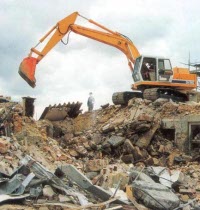The edict of Gary Reese, Mayor Pro Tempore and Vaquero Supreme of the Vegas Valley
As you may recall, Ted Marshall owns a warehouse in downtown Las Vegas. Like many buildings in downtown Las Vegas, Ted Marshall’s warehouse has been repeatedly vandalized by taggers. Like many property-owners in downtown Las Vegas, he covered up the graffiti several times, only to have new taggers come by and paint more on. Then, one day, he found some graffiti on his wall that he kind of liked, and he decided that he wanted to leave that design up on his own building’s wall. So the city of Las Vegas fined him $930 for having graffiti he wanted up on a wall he owns.
Ted Marshall thought this was bull crap: the city government shouldn’t force him to pay to get rid of a design that vandals put up without his permission, and, while we’re at it, the city government shouldn’t force him to pay fines for leaving designs he wants to leave up on his own building. Ted Marshall’s representative
on the city council, Mayor Pro Tem Gary Reese, replies:
I don’t want graffiti on any buildings in the city of Las Vegas. He said it was artistic or something, but for me, it’s a crime. For him to stand there and say he’s sick and tired and he’s going to leave it how it is — that’s bull crap.
Please remember that in the view of the Las Vegas city council, what matters is what Mayor Pro Tem Gary Reese does or does not want on buildings in the city of Las Vegas — certainly not what the mere owners of those buildings want or do not want on them.
Mary Price, falsely identified as a spokeswoman for the city of Las Vegas (actually, she speaks for the government, not for the city), adds:
It’s like
any other situation where you have property damage,city spokeswoman Mary Ann Price explains.If you had a burned-out building … it creates a hazard. You as the property owner would be responsible for it.
She’s right that this is just like any other situation where you have property damage. As long as a burned-out building, no matter how hazardous,
doesn’t actually threaten to damage anybody else’s property, the city government has absolutely no business forcing the property owner to fix that up, either, if she would rather not do so. Why should they?
The Review-Journal‘s editorial board informs us that The whole issue is surprisingly simple, once viewed through the lens of property rights.
Indeed it is. The issue here is that Mary Ann Price and Gary Reese — by the grace of Law Mayor Pro Tempore, Defender of Order, and Vaquero Supreme of the Vegas Valley — believe that the whole city of Las Vegas is their own rightful property, by concession of the sovereign state and federal governments, which the supposed owners
of land and buildings really only lease on Gary Reese’s terms and at his pleasure. They believe that they have the right to tell you what they do or don’t want to see, how they do or don’t want it used, and who you can or cannot invite to use it, in the name of maintaining what they see as good taste, or good business, or protecting the property values in their personal domains. If you’re not interested in helping them maintain a touch of class with the land or the buildings that you were foolish enough to think you owned, then they tell you that your claim is bull crap,
that their opinions about the proper disposal of your building matter far more than yours, and they will send professional busybodies and armed thugs to inform you of your responsibilities,
then to harass you, shove you around, fine you, and ultimately to jail you or kill you if you should resist their efforts to collect.
